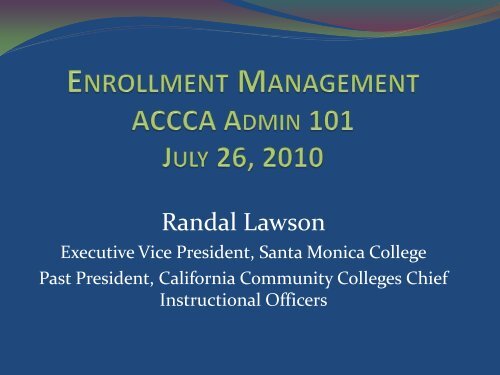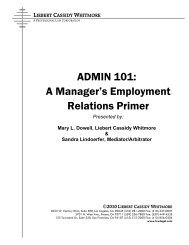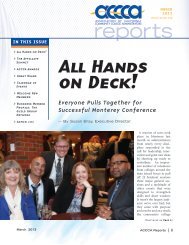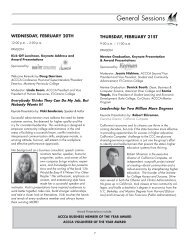ENROLLMENT MANAGEMENT ACCCA ADMIN 101 July 23, 2007
ENROLLMENT MANAGEMENT ACCCA ADMIN 101 July 23, 2007
ENROLLMENT MANAGEMENT ACCCA ADMIN 101 July 23, 2007
Create successful ePaper yourself
Turn your PDF publications into a flip-book with our unique Google optimized e-Paper software.
WHAT IS <strong>ENROLLMENT</strong> <strong>MANAGEMENT</strong>?It is…‣ An institutional commitment and an integral part ofstrategic planning‣ A clear articulation of institutional enrollment goals(well beyond sheer numbers)‣ A plan that aligns services and resources under theumbrella of a larger vision‣ A data-driven strategy‣ A living plan that is constantly changing as institutionalneeds change
WHO SHOULD BE INVOLVED?At the operational planning level—Key Administratorsand their Management Teams:‣Chief Instructional Officer‣Chief Student Services Officer‣Chief Business Officer‣Chief Information Services Officer‣Institutional Researcher‣Marketing/Public Information Administrators
WHAT INFORMATION IS NEEDED?‣ Reliable historical enrollment, course offering, andbudget data‣ Useful “what if” projection tools based upon thesehistorical data‣ Ability to actively monitor progress so that timelyadjustments can be made‣ Identification of key performance indicators‣ Identification of benchmarks
SCHEDULE OF CLASSES‣Focus of Academic and Fiscal Planning‣Central to community college mission‣Primary source of both institutional income andexpenditures‣Must balance consideration of academic needs andfiscal realities
SCHEDULE PLANNING—FISCAL CONSIDERATIONS‣Size of the schedule:‣ To grow or not to grow…‣ Is growth funded?‣ How much growth can you afford?‣ Costs of additional faculty and staff‣ Impact of other projected expenditures‣ What is the capacity for growth?‣ Facilities/Budget for Distance Education Support‣ Adequate numbers of faculty in targeted areas‣ Adequate student support services
SCHEDULE PLANNING—MEETING STUDENT NEEDS‣ Establish culture of basing recommendations and decisionson information rather than institutional “myths”‣ Importance of good historical information regardingstudent demand patterns, such as:‣ History of course offering size and distribution‣ History of individual course offering experience/trends:‣ Courses with Largest Enrollments‣ High Enrollment/Demand Courses‣ Low Enrollment/Demand Courses‣ Course cancellations/additions during previous registrationperiods‣ Course Fill Rates
SCHEDULE PLANNING—MEETING STUDENT NEEDS‣Provide effective “friendly” formatting of suchinformation to all involved in the schedulingprocess‣Allocate specific numbers of course sections todivision/departments‣Establish and enforce specific class time patterns‣Maintain appropriate balance among time patternsand days of offering
SCHEDULE PLANNING—MEETING STUDENT NEEDS‣Allocate classrooms to divisions/departments‣ Class size/room capacity match‣ Avoid culture of departmental “control” (priority ratherthan entitlement; establish point in time whereclassrooms revert to general use)‣ Monitor facilities use data and adjust the offeringaccordingly‣Consider online vs. “on ground” distribution ofcourse sections
SCHEDULE PLANNING—MEETING STUDENT NEEDS‣Faculty Assignment and Load—Legal and Contractualissues‣ Full-Time Faculty:‣ Contract Load‣ Overload‣ Assignment Preference Provisions‣ Banking of Contract Load
SCHEDULE PLANNING—MEETING STUDENT NEEDS‣Faculty Assignment and Load—Legal and Contractualissues‣ Part-Time Faculty:‣ 67% Law (formerly 60% Law)‣ Contractual Re-employment Provisions‣ Class Size—Minimum and Maximum‣ Often some conflict between effective scheduling andcontractual obligations‣ Need for district instructional “voice” in collectivebargaining
SCHEDULE PLANNING—MEETING STUDENT NEEDS‣Daily active monitoring of the schedule duringregistration periods‣ Evaluate match between actual student enrollment andthe course offerings‣ Make necessary scheduling adjustments in a timelymanner‣ Constant communication/interaction amongInstruction, Counseling, and Enrollment Services‣Evaluate effectiveness of each schedule, learn fromyour successes and mistakes, and use for next schedule
SCHEDULING MECHANICS‣Definitions…‣ Daily Contact Hours (DCH):Meeting time per day‣ Daily Student Contact Hours (DSCH):Daily Contact Hours × Number of Students‣ Weekly Contact Hours (WCH):Daily Contact Hours × Class Meeting Days‣ Weekly Student Contact Hours (WSCH):Weekly Contact Hours × Number of Students
SCHEDULING MECHANICS‣The 50-Minute Hour‣ CCC “Alternative Math” for calculating contact hours‣ Basic Concept—That each clock hour consists of 50minutes of instruction and 10 minutes of passing time(between classes) or break time (within multi-hourclasses)
SCHEDULING MECHANICS‣The 50-Minute Hour‣ Multi-Hour Class Example (7:00 p.m. to 10:00 p.m.)‣ 150 minutes of instruction; 30 minutes of break/passingtime‣ When classes extend beyond the hour by a fractionalamount‣ Beginning with 0.3 hours— representing 5 minutes beyondthe hour—contact hours increased by 0.1 for each 5-minuteincrement‣ Crucial calculation for compressed calendar meeting timesand intersession/short-term class meeting time
SCHEDULING MECHANICS—50-MINUTE HOURMeeting Time50 minutes 1.055 minutes 1.060 minutes 1.065 minutes 1.370 minutes 1.475 minutes 1.580 minutes 1.685 minutes 1.790 minutes 1.895 minutes 1.9100 minutes 1.9105 minutes 1.9110 minutes 2.0115 minutes 2.0120 minutes 2.0DCH
SCHEDULING MECHANICS—50-MINUTE HOUR
SCHEDULING MECHANICS‣More Definitions…‣ Census—a reporting “snapshot in time” atapproximately the 20% point of a course‣ Weekly Census—attendance reporting type for coursesections that are regularly scheduled for the fullsemester‣ Daily Census—Attendance reporting type for coursesections that meet on a regular basis for at least fivedays, but meet for less than the full semester‣ Most intersession course sections‣ Short-Term course offerings within a regular semester
SCHEDULING MECHANICS‣And Still More Definitions…‣ Positive Attendance—Attendance reporting type basedupon actual student attendance for the course section‣ All Noncredit Courses‣ Irregularly Scheduled and Open Entry/Open Exit Courses‣ Alternative Attendance Accounting Method‣ Includes Independent Study/Work Experience—Attendancereporting type based upon units rather than contact hours‣ Non-Classroom Based Instruction‣ Also includes most online instruction‣ Also includes WSCH-based FTES calculation for lab hours(Online Labs, TBA Hours)
SCHEDULING MECHANICS‣ Term Length Multiplier (TLM)—Number of weeks of instructionin regular fall/spring semesters‣ Inclusive of all days of instruction, final exam days, and approvedflexible calendar days‣ Standard Term Length Multiplier—17.5‣ Compressed Calendars—range from 16.0 to 17.0‣ Quarter System Calendars—11.67‣ Full-Time Equivalent Student (FTES)—the equivalent of onestudent enrolled 15 hours per week for two 17.5-week semesters‣ Both enrollment measure and funding “currency”‣ Calculation understanding essential for enrollment management‣ 15 Hours × 35 Weeks = “Magic Number” of 525
FTES—CENSUS WEEKLY FORMULAFull Term—Calculated at Census (20% of TermLength)
FTES—CENSUS WEEKLY EXAMPLEClass of 30 students meeting 75 minutes per daytwice a week (equals 3.0 WCH) for 17.5 weeks(Standard Term Length Multiplier):
FTES—CENSUS DAILY FORMULALess Than Full Term—Calculated at Census (20%of Class Meetings)
FTES—CENSUS DAILY EXAMPLEClass of 30 students meeting 90 minutes per day(1.8 DCH) with 29 class meetings (6 weeks, 5 daysper week, 1 holiday):
FTES—POSITIVE ATTENDANCE FORMULA
FTES—POSITIVE ATTENDANCE EXAMPLEClass of 30 students meeting a total of 3 hours perweek (3.0 WCH) for 17.5 weeks), with reportedattendance hours at 90% of “Perfect Attendance:”
FTES—INDEPENDENT STUDY FORMULA
FTES—INDEPENDENT STUDY EXAMPLE3-Unit Class with 30 Students Meeting for 17.5weeks (Standard Term Length Multiplier):
FTES—Alternative AttendanceAccounting Method FormulaFull Term—Calculated at Census (20% of TermLength)
FTES—Alternative AttendanceAccounting Method ExampleClass of 30 online lab students meeting 3 hoursper week (equals 3.0 WCH) for 17.5 weeks(Standard Term Length Multiplier):
EFFICIENCY/PRODUCTIVITY MEASURES‣WSCH per FTEF (Weekly Student Contact Hours perFull-Time Equivalent Faculty)‣ Different FTEF Calculations according to what is beingmeasured‣ Include only “in classroom” time—measure of class sizeefficiency‣ Include all compensated time (include release/reassignedtime) of teaching faculty—measure of instructional budgetefficiency‣ Generally, 500-525 WSCH per FTEF considered “acceptable”‣ Most useful as internal measure over time
EFFICIENCY/PRODUCTIVITY MEASURES‣FTES per FTEF (Full-Time Equivalent Students perFull-Time Equivalent Faculty)‣Comparative Annual Faculty Assigned Hour Use byDepartment/Discipline‣Comparison of Faculty Assigned Hours and FTES‣Fill rates; Percentage of available “seats”‣Classroom Utilization Studies‣Know your “break even” point in terms of FTESrevenue vs. direct instructional costs
MARKETING AND PROMOTION‣Determining your basic message‣ If all advertising and recruiting were to disappear, whatwould create positive “word-of-mouth” for your college?‣ What negative “word-of-mouth” do you need toovercome?‣ Establishing image and “brand” just as important asspecific targeted enrollment campaigns‣ Communicate a consistent message—contributes to“Look and Feel”‣ Be sure that performance lives up to claims
MARKETING AND PROMOTION‣Create a positive “word-of-mouth”‣ Focus on the student experience‣ How convenient are the services you offer?‣ Wait time in lines‣ Availability of services when and where they are needed‣ Consistency of service delivery—Do staff have a serviceattitude?‣ Website Navigation‣ Leverage the use of technology‣ Acknowledge institutional challenges and demonstratethat you are doing everything you can to help
MARKETING AND PROMOTION‣ Create a positive “word-of-mouth”‣ Focus on the student experience‣ Get students involved in “connecting with other students”‣ Tour Guides‣ Informational Ambassadors‣ Involve student clubs in welcoming new students‣ Be sure students have a voice in planning and then “championingthe cause”‣ Student Surveys‣ Focus Groups‣ Student representation on planning committees‣ Anecdotal Data (Student “Stories”)
MARKETING AND PROMOTION‣ Marketing is communication‣ Both external and internal‣ Not just expensive media buys‣ Direct mail‣ E-Mail‣ Communicating with current students and those who left, not justwith prospective new students‣ Effective use of college website‣ Schedule of Classes (both printed and online)‣ Personalized communication‣ Promotional Items/Services‣ Effective use of community events
MARKETING AND PROMOTION‣Challenges‣ External‣ Reaching non-traditional student populations (18-24year olds who have “stopped out” of education)‣ Getting too caught up in attempting to compete directlywith other community colleges‣ Remember that we all share the same missions, so our“messages” tend to be similar‣ Successfully communicating the “message” of oneinstitution can be of benefit to all community colleges.
MARKETING AND PROMOTION‣Challenges‣ Internal‣ “Everyone’s an expert” syndrome‣ Marketing often a target in budget planning discussions‣ Focus on single “message” can result in sense that otherprograms and services are considered less important.
<strong>ENROLLMENT</strong> SERVICES‣Outreach‣ More than recruitment—partnership with your community‣ You have to be seen to be known‣ Relationship with feeder high schools—creating personalrelationships with counselors and students‣ High School Dual/Concurrent Enrollment‣ Community events (literacy fairs, church fairs, communitygatherings, etc.)‣ Host students on campus‣ Workshops/information booths for campus events‣ Participate in national college fairs and national organizations‣ Develop international student outreach and recruitment plan
<strong>ENROLLMENT</strong> SERVICES‣Financial Aid‣ Plays key role in both access and retention‣ No access to education for many students withoutfinancial aid‣ Timeliness of disbursement critical to student success‣ Are student award letters distributed in time for students tomake decisions about their education?‣ What happens to student success if students cannot afford tobuy textbooks?‣ Statewide campaign—icanaffordcollege.com
<strong>ENROLLMENT</strong> SERVICES‣Admissions and Registration‣ Not a passive process—requires daily active monitoring(in concert with Instruction)‣ Student Flow—New Students‣ Unknowns—never contacted the college‣ Prospects—contacted the college, have not enrolled‣ Applicants—applied, have not enrolled‣ Students—applied, enrolled‣ Alumni—left the college, but may return and/or encourageothers to attend the college
<strong>ENROLLMENT</strong> SERVICES‣Admissions and Registration‣ Student Flow—Continuing Students‣ Non-committed—enrolled, dropped all courses beforecensus‣ Short-timers—enrolled, completed at least one course,have not re-enrolled‣ Stop-outs—enroll, stop, come back‣ Committed—enroll, carry at least a partial load, persistthrough number of terms with limited stop out, maycomplete degree/certificate/transfer requirement
<strong>ENROLLMENT</strong> SERVICES‣Active monitoring of enrollment‣ Not just overall headcount numbers‣ Monitor, assess, and act based upon what categories ofstudents may not be registering‣ New students?‣ Continuing students?‣ Returning students?‣ Nonresident students?
STUDENT RETENTION/PERSISTENCE‣Don’t forget about student retention and persistence‣ Not just the “right thing to do” as educators‣ Also a key part of Enrollment Management‣Welcoming approach to service delivery should not belimited just to outreach/orientation of new students‣At-Risk Student Populations‣ Probation (academic and progress)‣ Targeted services for special populations‣ “Early Alert” activities
REPORTING AND COMPLIANCE‣CCFS-320 Report‣ Primary basis for college funding‣ Needs to be cooperative effort among Fiscal, Instruction,and Enrollment Services staff‣ Reporting of Total WSCH for each attendance type andfor each semester/intersession to arrive at total FTESnumber‣ Weekly Census‣ Daily Census‣ Positive Attendance‣ Independent Study/Work Experience
REPORTING AND COMPLIANCE‣CCFS-320 Report‣ Three regular reporting periods (the first two requiringuse of annualizers)‣ P1 (First Principal Apportionment)—January 15‣ Gives System Office initial idea of total system enrollment‣ In turn, System Office gives districts initial take on howvarious funding streams (growth, etc.) may be allocated.‣ P2 (Second Principal Apportionment)—April 15‣ Although still an estimate, used as the basis for initialfunding allocation (subject to Recalculation/Prior YearAdjustments in February of the following year)
REPORTING AND COMPLIANCE‣CCFS-320 Report‣ Annual Report—<strong>July</strong> 15‣ Any changes from P2 submittal reflected in Recalculation ofApportionment in February of following year‣ Recal Report—November 1‣ Opportunity to submit amended/corrected report prior toRecalculation of Apportionment in February of following year
ONLINE REFERENCES AND RESOURCES‣Student Attendance Accounting Manual:http://www.cccco.edu/divisions/cffp/fiscal/allocations/links/manuals/saa_manual.htm‣Student Attendance Accounting Manual Addendum:http://www.cccco.edu/Portals/4/CFFP/Fiscal/Allocations/manuals/SAAM_Compressed_Calendar_and_CourseScheduling_Addendum_FINAL_9-18-08.pdf[Divisions/Fiscal Services Unit/Manuals andPublications]
CONTACT INFORMATIONRandal LawsonExecutive Vice PresidentSanta Monica Collegelawson_randal@smc.edu







